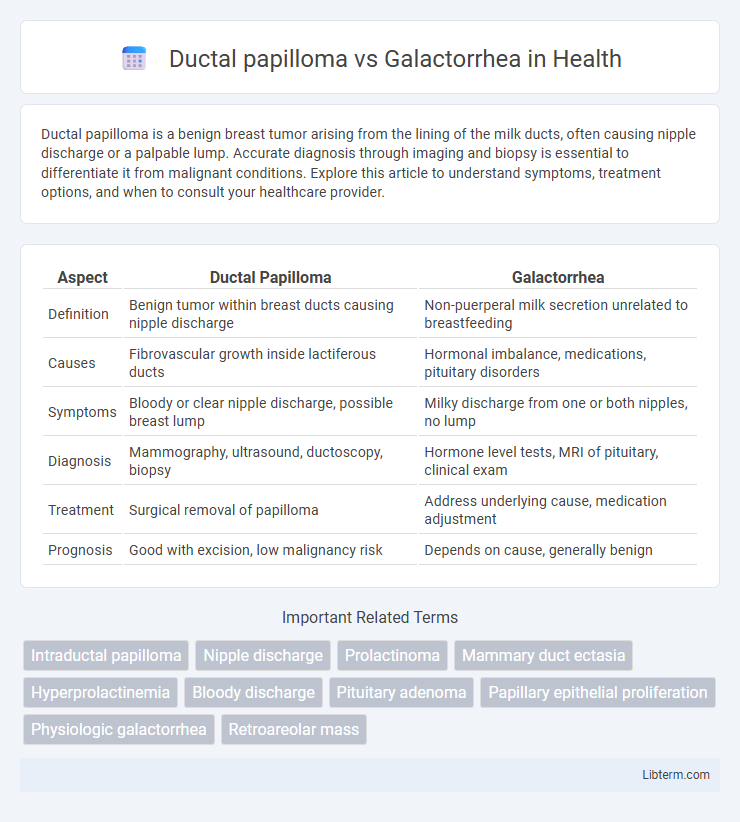Ductal papilloma is a benign breast tumor arising from the lining of the milk ducts, often causing nipple discharge or a palpable lump. Accurate diagnosis through imaging and biopsy is essential to differentiate it from malignant conditions. Explore this article to understand symptoms, treatment options, and when to consult your healthcare provider.
Table of Comparison
| Aspect | Ductal Papilloma | Galactorrhea |
|---|---|---|
| Definition | Benign tumor within breast ducts causing nipple discharge | Non-puerperal milk secretion unrelated to breastfeeding |
| Causes | Fibrovascular growth inside lactiferous ducts | Hormonal imbalance, medications, pituitary disorders |
| Symptoms | Bloody or clear nipple discharge, possible breast lump | Milky discharge from one or both nipples, no lump |
| Diagnosis | Mammography, ultrasound, ductoscopy, biopsy | Hormone level tests, MRI of pituitary, clinical exam |
| Treatment | Surgical removal of papilloma | Address underlying cause, medication adjustment |
| Prognosis | Good with excision, low malignancy risk | Depends on cause, generally benign |
Overview of Ductal Papilloma and Galactorrhea
Ductal papilloma is a benign breast tumor characterized by the growth of wart-like lesions within the milk ducts, often causing nipple discharge or localized breast pain. Galactorrhea refers to the spontaneous flow of milk from the nipple unrelated to breastfeeding, typically linked to hormonal imbalances such as elevated prolactin levels. Distinguishing between ductal papilloma and galactorrhea is essential for accurate diagnosis and treatment, with imaging studies and hormone assays playing key roles.
Key Differences in Presentation
Ductal papilloma typically presents as a solitary, small, benign tumor in the breast ducts causing bloody or serous nipple discharge, often associated with a palpable lump. Galactorrhea involves a persistent, non-puerperal milky nipple discharge unrelated to pregnancy or breastfeeding, frequently linked to hormonal imbalances or medication side effects without an underlying mass. Unlike ductal papilloma, galactorrhea lacks localized breast abnormalities and is diagnosed primarily through hormonal evaluation and clinical history.
Causes and Risk Factors
Ductal papilloma is caused by benign growths within the milk ducts of the breast, often linked to hormonal changes and an unknown precise etiology, primarily affecting women aged 35 to 55. Galactorrhea results from hormonal imbalances, particularly elevated prolactin levels due to pituitary disorders, medications, or hypothyroidism, occurring in both women and men. Risk factors for ductal papilloma include female gender and age, while galactorrhea risk factors encompass endocrine disorders, certain drugs like antipsychotics, and chest trauma.
Clinical Symptoms and Signs
Ductal papilloma typically presents with unilateral, spontaneous nipple discharge that may be bloody or serous, often accompanied by a palpable subareolar mass. Galactorrhea is characterized by bilateral, milky nipple discharge unrelated to breastfeeding, often associated with endocrine disorders like hyperprolactinemia, without a palpable breast mass. Pain and signs of inflammation are less common in both conditions but may help differentiate ductal papilloma from infectious causes.
Diagnostic Approaches
Ductal papilloma is primarily diagnosed through imaging techniques such as mammography and ultrasound, often supplemented by ductography to visualize intraductal lesions. Galactorrhea diagnosis relies on clinical evaluation combined with laboratory tests to measure serum prolactin levels and hormonal assessments, along with imaging studies like MRI to exclude pituitary adenomas. Fine-needle aspiration or biopsy may be employed in ductal papilloma cases for histopathological confirmation, while galactorrhea diagnosis focuses on identifying underlying endocrine disorders.
Imaging and Laboratory Investigations
Ductal papilloma diagnosis relies heavily on imaging techniques such as mammography and ductography, which reveal intraductal masses or filling defects within the milk ducts, while ultrasound helps characterize lesion size and vascularity. Galactorrhea evaluation primarily involves laboratory investigations including serum prolactin levels, thyroid function tests, and renal function tests to identify hormonal imbalances or underlying systemic causes. Imaging is less specific in galactorrhea but may be used to rule out masses, whereas ductal papilloma requires targeted duct imaging for accurate localization and surgical planning.
Pathology and Histological Features
Ductal papilloma is a benign intraductal tumor characterized by fibrovascular cores lined by both epithelial and myoepithelial cells, often presenting with papillary fronds within dilated ducts. Histologically, it shows proliferation of well-organized papillary structures without cellular atypia, whereas galactorrhea involves non-pathological milk discharge with no associated histological abnormalities in breast tissue. Pathologically, galactorrhea is linked to hyperprolactinemia or hormonal imbalances without ductal proliferation or papillary lesions.
Treatment Options and Management Strategies
Ductal papilloma treatment typically involves surgical excision to remove the benign tumor and prevent recurrence, while galactorrhea management targets the underlying cause, often treated with dopamine agonists like bromocriptine or cabergoline to reduce prolactin levels. Monitoring hormone levels and addressing contributing factors such as medication side effects or thyroid dysfunction are essential for effective galactorrhea control. Regular follow-up imaging and clinical evaluations are recommended for ductal papilloma to ensure complete removal and detect any malignant transformation.
Prognosis and Potential Complications
Ductal papilloma typically has a favorable prognosis with low malignant potential, but may cause nipple discharge and occasional ductal obstruction leading to infection or abscess. Galactorrhea, often related to hormonal imbalances or medications, usually resolves with treatment of the underlying cause and rarely results in serious complications. Both conditions require accurate diagnosis to prevent mismanagement and ensure appropriate monitoring for any progression or association with malignancy.
Summary Table: Ductal Papilloma vs Galactorrhea
Ductal papilloma is a benign breast tumor characterized by the presence of solitary or multiple papillomas within the lactiferous ducts, often causing bloody nipple discharge and a palpable mass. Galactorrhea is a non-pathological milky nipple discharge unrelated to breastfeeding, frequently associated with hormonal imbalances such as hyperprolactinemia or medication side effects. The summary table contrasts ductal papilloma's focal ductal lesions and bloody discharge with galactorrhea's diffuse secretion and hormonal etiology.
Ductal papilloma Infographic

 libterm.com
libterm.com